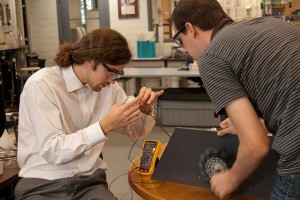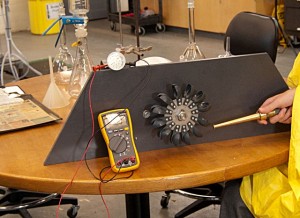
Elliott Mitchell-Colgan ’12, left, and Thomas Benjamin ’12 work on their prototype.
When severe floods and storms knock out the electricity, the effects can range from a mild nuisance to the devastating inability to help victims reach safety and save lives. In those situations, there is one resource in spades — water.
Thomas Benjamin ’12 (Norristown, Pa.), a double major in chemical engineering and government & law, and Elliott Mitchell-Colgan ’12 (Henderson, Nev.), an electrical and computer engineering major, are designing a light (only 22 pounds) and portable hydropower system that would use excess water to rescue crews’ advantage. Patricia Darcy, assistant professor of chemical and biomolecular engineering, is mentoring them.
“Imagine the power going out in a flood and a rescue team needed to find someone being carried away by the current in the night,” says Mitchell-Colgan. “If there is no other source of power, there will be no light, and most probably no rescue. If there is a floodlight, the chances increase reasonably. We’re trying to mitigate the drastic changes which come from power outages in normal conditions, or when there are storms or floods when power is needed most.”
Benjamin and Mitchell-Colgan’s project is part of the Grand Challenges Scholars Program. In 2008, the National Academy of Engineering identified 14 Grand Challenges for Engineering in the 21st century, one of which is to “restore urban infrastructure.” Three other Lafayette groups also were selected to receive support through the program: Emily Melvin ’12 (Seaford, N.Y.); Yue (Luna) Yuan ’12 (Wuhan, China) and Felix Hutchison ’12 (Plainsboro, N.J.); and Jared Katz ’12 (Stoneham, Mass.) and Katherine Metcalf ’12 (Springfield, Va.).

A close-up of the prototype
Beginning their projects this summer, they will complete them in their senior year. Through a gift from a Lafayette alum, each student receives $3,000 in summer research stipends, in addition to a $3,000 budget for project expenses, on-campus summer housing, and $1,000 to participate in the Grand Challenges Scholars Program National Summit during their senior year. The Grand Challenges program at Lafayette is unique in that the students must take an interdisciplinary approach to solving their problems, combining engineering with the liberal arts.
One of the major problems with hydroelectric systems is that they are designed for large amounts of power, something that is inaccessible in remote areas of the world. A rural village in a third world country, for instance, needs a smaller, less expensive design. Benjamin started thinking about a small, deployable system in his Experimental Design II course, where students learned about distillation columns, heat exchangers, packed bed columns, and pumps.
“Water is the world’s most abundant resource, and in some areas of the world, the scarcest and most sought after,” says Benjamin, who is vice president of the International Students Association and multicultural affairs chair of Student Government. “In our time, electric power is considered a vital part of shelter, a basic human need. Providing electric power to very remote areas through use of the world’s natural, renewable resources is a humanitarian goal that transcends nations.”
Benjamin and Mitchell-Colgan developed a flood drain system that they plan to test in a stream. Although the stream’s current will be slower than that of a flood, the experiment will give the team a reasonable idea of whether their system is feasible in severe weather. If all goes well, they’ll be able to pitch it to rescue aid organizations.
Mitchell-Colgan plans to pursue graduate studies in renewable energy or computer organization, and the Grand Challenges project gives him valuable research experience for his résumé.
“The common denominator is efficiency. I find efficiency beautiful,” he explains. “This project has taught me a lot and will continue to offer me independent research experience that I don’t think everyone has. Engineering projects in general usually demand multiple skill sets. Our small-scale project has water flow, mechanics, and electricity generation, not to mention social and economical impacts.”
Those impacts especially appeal to Benjamin, who plans to pursue a master’s degree in higher education administration, an idea that came to him when his Introduction to Engineering professor proposed there should be more engineers in government and public service. He believes the blend of engineering and liberal arts that make up his undergraduate education will be very useful moving forward, just as it has been for the Grand Challenges project.
“Our generation will be responsible for resolving many of the world’s current problems — our ‘grand challenges’ — and science and technology are at the forefront of the solutions,” he says. “This project is at the intersection of the different engineering disciplines, and the possibilities for its use on a global scale span the various disciplines of the liberal arts.”


2 Comments
Comments are closed.